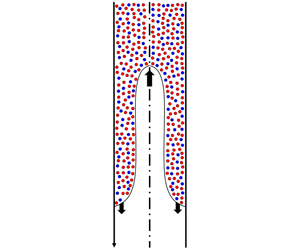Published online by Cambridge University Press: 23 March 2020

Buoyancy-driven exchange flow in a vertical duct is studied theoretically for a light pure fluid and a heavy fluid. The latter is a suspension composed of a Newtonian fluid and two populations of negatively buoyant particles of the same size but different densities (bidensity). In a previous study (Mirzaeian & Alba, J. Fluid Mech., vol. 847, 2018, pp. 134–160), the authors developed a lubrication model for monodensity suspension of particles of uniform size. The main observation of the monodensity study was the discovery of particle-enriched zones near heavy and light fluid fronts due to the relative motion of particles and the fluid. Distinct from the previous work, here, mismatched densities instigate a relative motion of lighter and heavier particles in addition to the movement of fluids. Other than the previously observed enrichment case, the bidensity case gives rise to a novel flow regime where there is enrichment of heavy particles but depletion of light particles near the interface. The transition to this regime is governed by a balance between the densities of heavy and light particles as well as those of light and carrying fluids for a given choice of initial volume fractions of particles. Such density balance is characterized by two dimensionless parameters comprising light and heavy particle-to-carrying-fluid density ratios. The transition mechanism is studied through additional simulations, revealing that the former increases with initial volume fraction of particles of either type, while the latter contrarily decreases. The effect of other parameters on the flow are discussed within the context of the paper.